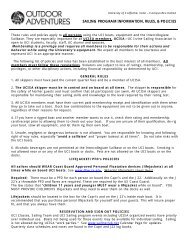J22 Manual - UCI Campus Recreation
J22 Manual - UCI Campus Recreation
J22 Manual - UCI Campus Recreation
You also want an ePaper? Increase the reach of your titles
YUMPU automatically turns print PDFs into web optimized ePapers that Google loves.
<strong>UCI</strong> J/22 Sailing <strong>Manual</strong> 24<br />
the sail to luff first.<br />
C- Just Right: Here is how the telltales fly when the fairlead is properly adjusted.<br />
The Slot:<br />
The area between the mainsail and jib is called the slot. When sails are<br />
adjusted incorrectly, or are cut too flat or too full by the sail maker, the<br />
slot may be less than ideal. When the slot is too closed (not enough<br />
distance between the sails) the boat may heel excessively, or the<br />
mainsail may backwind. When the slot is too open (too much distance<br />
between the sails), the sails may not develop enough lift to windward,<br />
and the boat will not point well or sail fast to windward. A good rule of<br />
thumb is to keep the leech edge of the jib at 90 degrees to the spreader<br />
when the sail is pulled in all the way. If it is pulled in too tight, that will<br />
not be a 90-degree angle.<br />
Understanding the Wind<br />
In order to maintain speed and keep sails properly trimmed, you need to understand the wind.<br />
Wind strength and direction can change so you will need to respond appropriately. You should<br />
understand the terms used below to describe the wind so that you can communicate easily<br />
with other sailors to sail the boat properly.<br />
Puffs and Lulls<br />
A puff is a temporary increase in wind velocity marked often by a dark patch of water. A lull is a<br />
temporary loss of wind speed in which you may see a smooth patch of water.<br />
Wind Shifts<br />
Header<br />
A header is a wind shift toward the bow of your boat. If close hauled<br />
you will have to fall off (turn away from wind).<br />
Lift<br />
A lift is a wind shift away from your bow, allowing you to head up (turn<br />
closer into the wind).<br />
True Wind<br />
The "true wind" is the actual wind blowing. You will feel this at a fixed point, such as standing<br />
on the docks.<br />
Apparent Wind (the wind you sail in)<br />
Apparent wind is the combination of the true wind and the wind created by the boat moving<br />
forward. If your speed or the true wind speed changes, the apparent wind will not only change<br />
in speed, but also in direction.<br />
You may notice that apparent wind is less when<br />
traveling downwind because you are moving the<br />
same direction as the wind. When you are not going<br />
directly away from the wind, your apparent wind will







